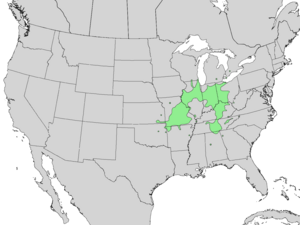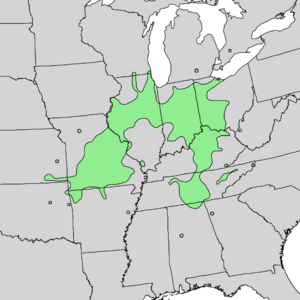Blue ash facts for kids
Quick facts for kids Blue ash |
|
|---|---|
 |
|
| Conservation status | |
| Scientific classification | |
| Genus: |
Fraxinus
|
| Species: |
quadrangulata
|
 |
|
| Natural range of Fraxinus quadrangulata | |
 |
|
| Close-up of natural range of Fraxinus quadrangulata | |
The blue ash (scientific name: Fraxinus quadrangulata) is a type of ash tree. It mainly grows in the Midwest of the United States. You can find it from Oklahoma up to Michigan. It also grows in parts of Kentucky and Tennessee.
Some blue ash trees are found in Alabama and Southern Ontario, Canada. They also grow in small areas of the Appalachian Mountains. These trees usually prefer soils with limestone. They like growing on limestone slopes and in wet valley areas. You can find them at heights of 120 to 600 meters above sea level.
Contents
What Does the Blue Ash Look Like?
The blue ash is a medium-sized deciduous tree. This means it loses its leaves every autumn. It usually grows to be 10 to 25 meters tall. Its trunk can be 50 to 100 centimeters wide.
Unique Twigs and Leaves
A special feature of the blue ash is its twigs. They often have four corky ridges. These ridges make the twigs look square when you cut them. This is why its scientific name is quadrangulata, which means "four-angled." The tree's winter buds are reddish-brown.
The leaves are quite long, about 20 to 38 centimeters. Each leaf has 5 to 11 smaller leaflets. Most often, there are 7 leaflets. These leaflets are 7 to 13 centimeters long and 2.5 to 5 centimeters wide. Their edges are rough and jagged. Each leaflet has a short stem called a petiolule.
Flowers and Fruit
The blue ash tree produces small, purplish flowers. These flowers appear in early spring. They bloom before the leaves grow. The fruit of the blue ash is called a samara. A samara is a special type of winged seed. Each samara is 2.5 to 5 centimeters long. It is 6 to 12 millimeters wide, including its wing.
History and Uses of Blue Ash
The name "blue ash" comes from a special dye. This dye is black and can be taken from the tree's inner bark. People would soak the bark in water to get the dye.
Traditional Uses
Early European settlers and American pioneers used this dye. They colored yarn with it. This yarn was then used to make textiles. People used it for sewing, crocheting, and knitting. They also used it for weaving and embroidery.
The wood from blue ash trees is very useful. It is used to make flooring and baseball bats. People also use it for furniture and tool handles. It's strong enough for crates and barrels too. The city of Blue Ash, Ohio is named after these trees. Many of the first buildings there were made from blue ash logs.
Importance for Wildlife
North American ash trees are important for frogs. The leaves that fall from these trees are a good food source for tadpoles. Tadpoles eat them in ponds, puddles, and other water sources. Other trees, like red maple, are replacing ash trees. This is happening because of the emerald ash borer. However, maple leaves are not as good for tadpoles. This can lead to fewer frogs surviving and growing smaller.
Ash trees also provide homes and food for many other native animals. It's important to protect them for the health of the ecosystem.
Protecting the Blue Ash Tree
Since 2014, the blue ash has shown some resistance to the emerald ash borer. This invasive beetle was first found in North America in 2002. It has since spread across much of the blue ash's natural home.
Threat from the Emerald Ash Borer
The emerald ash borer is a big threat to ash trees. It kills most ash trees it infects. About 60 to 70 percent of blue ash trees survive an infestation. This is much better than other ash types. For example, black ash and green ash can have up to 99 percent of their trees killed.
In 2017, the IUCN listed the blue ash as Critically Endangered. Other ash trees from the Eastern United States, like the black ash, green ash, and white ash, are also on this list. This is because the emerald ash borer has grown so much. It is causing a huge decline in ash tree populations.
See also
 In Spanish: Fresno azul para niños
In Spanish: Fresno azul para niños


